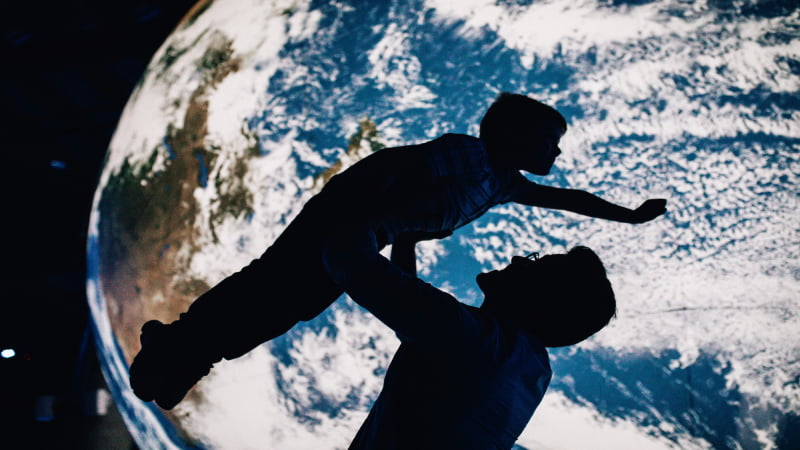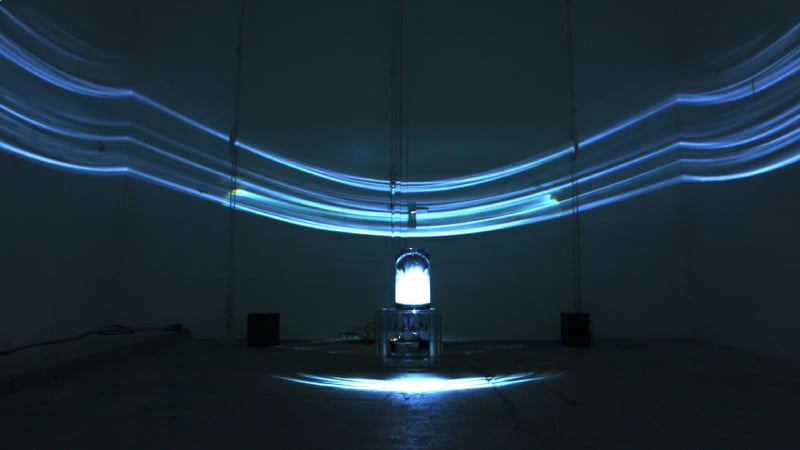
‘Gaia’ by Luke Jerram, source
Light Night is Leeds’s annual event in which a series of light-themed installations and exhibitions are put in place across the city. The event not only gives artists a chance to be exhibited outside a gallery space, but also allows locals and visitors to experience art in a new and exciting setting. This year’s Light Night saw many works exploring the theme of climate change. By bringing art to the streets, and allowing the event to deliver a consistent and important message, culture’s ability to be informative was given centre stage throughout the duration of both nights.
One stand-out piece this year was Luke Jerram’s ‘Gaia’, a touring installation of a huge, glowing model of Earth hanging carefully above the ground. With a diameter of seven meters, its scale is impressive. Equally impressive, however was the quiet respect the installation seemed to inspire within the crowd which surrounded it.
The piece’s accompanying notes describe Earth as “hanging in the black emptiness of space”. That was not, however, how the planet was seen from Queen’s Square. Instead, the newly built, high-rise student accommodation buildings situated around Leeds Arena acted as its backdrop. This did not reduce its impact but instead created a sense of surrealism which added to the installation’s poignancy. The image of Earth as viewed from space was made visible against a hyper-modern city backdrop, a rare comparison of something we imagine to be unchanging, and something so recently changed. This image also evoked an understanding of the planet’s scale. The towers may seem huge, but were swallowed by the vastness of Earth which the piece made comprehensible. The installation also seeks to inspire the ‘Overview Effect’, wherein astronauts are said to achieve a change in perception after seeing the planet from afar, creating a new sense of responsibility towards it. In this way, the piece served to set the stage for the environmental issues tackled by other works at the event.

‘Climate Canopy’ by Alison Smith and the National Centre for Atmospheric Science, source
Alison Smith’s ‘Climate Canopy’, also sought to directly confront environmental concerns. Situated in a dark room inside the Carriageworks Theatre, the piece consisted of a canopy of light under which thin strands of recycled plastic hung at varying lengths. The lights which illuminated the piece serve as representations of 170 years of the Earth’s recorded temperatures, with blue lights symbolising a cooler climate and red an increase in temperature. Perhaps unsurprisingly, the piece flowed from a dark blue colour at its start to a dark red at the end, indicating a rise in overall global temperature.
These strands of plastic were also hung from the canopy in such a way that as the viewer walked through them, the red strands blocking their field of view. This contrasted with the blue segment of the piece which remained comfortably overhead. Here it seems the piece sought to show that for many years the climate has been nothing more than the blue sky which sits above us, something we perhaps barely notice. Now, however, the red warning signs are right in front of us, blocking our view from anything further ahead, and even hindering our path. To walk through the canopy was to be confronted by the stark reality of the climate catastrophe, whilst still being awed by the visual beauty of the piece. There is a certain irony in that something so aesthetically pleasing can represent something so devastating.

Wave Work by Opera North Projects, source
Opera North’s newly opened Howard Assembly Room saw two nights of live music led by cellist Clare O’Connell. These performances were accompanied by an installation by artist Akheelah Betram, where waves of light were projected around the room. Presented in this way, the room became a meditative space with many viewers sat on the floor with their eyes closed, or even lying down to gaze at the patterns of light which appeared to hang and tremble in the air. The installation’s title, ‘Wave Work’, gave a fitting summary of the feeling in the room, where the ebb and flow of the music was met by the sound-reactive visual patterns. The overall effect created a space to reflect on the greater themes of the event, reminding its viewers of the calming effect which often only nature can produce.
Richard Evans’s ‘SENTINEL’ was another stand out musical event which occurred over the course of the two nights. Taking place in Victoria Hall, the piece took excerpts from his larger audio-visual show of the same name which uses images of climate data and spoof news reel footage to address environmental issues. With visuals projected onto a cube which surrounded him, and sounds reminiscent of early electronic music pioneers such as Kraftwerk and New Order, Evans delivered an environmentally conscious message in an entertaining and visually enticing way. When coupled with ‘Wave Works’, we see two directly opposed approaches to creating an appreciation for nature and the environment. Both, however, were equally impactful.
The environmental themes of this year’s event were starkly present throughout every installation across the city. The event successfully merged family-friendly activities and installations with those that would usually be found in a more typical art space. Through doing so, it was able to relay its themes to a wide audience, and show the important role that arts and culture can play in addressing important issues. On an occasion perhaps usually associated with activities for children, the importance of culture shone through, showing how such events can be exciting for a variety of ages, whilst still being socially significant.
Filed under: Art & Photography

Comments